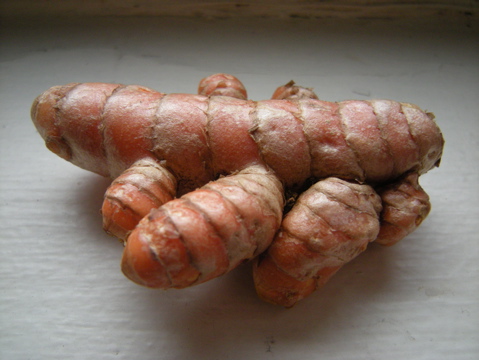It looks like ginger and belongs to the ginger family. The photo above is a fresh piece of turmeric root or curcuma longa, originally a plant native to Southern Asia and today mostly cultivated in India, China, Indonesia, Jamaica & Haiti. Anglophone countries call it turmeric, while Latin derived languages call it Curcuma and if you want to find out what it is in Chinese or other languages click here.
The word curcuma comes from the arabic khourkoum كم كر; though J.Favre, in the 19th century Dictionaire Universel de la Cuisine et de l’Hygiène Alimentaire, tells us that it comes from the Sanskrit kunkuma. Vijaata-kuGkuma in Sanskrit means *bastard saffron*. Turmeric is often referred to as cheap saffron, faux safron, indian saffron. It is its bright yellow dying agent that associates it with real saffron, but taste-wise one cannot replace the other. The *real* saffron is the stigma of the flower crocus sativa and one of the most pricey spices on the market.
Turmeric doesn’t have the sharp bite ginger has. A must for curry of course, but can be used in many other recipes. I have used it in lentil stew, lamb stew etc. Today I made a simple miso soup.
Miso Turmeric Soup
1/4 cup of finely chopped onion
1 carrot also finely chopped
1 piece of fresh turmeric
1/2 cup of see kelp
2 Tbsp of Miso
Sauté onions, carrots and turmeric in a sauce pan coated with olive oil. Add water, let simmer for 20 minutes. Meanwhile rehydrate your sea kelp. Add the sea kelp when they have softened. Add miso at the end. Serve with brown rice and kimchee. This is a very restaurative dinner.
Turmeric is known to be a potent healing rhizome; it has anti-oxidant & anti-inflammatory properties that are used in alternative medicine. There is an entire book on the subject that I just discovered: Turmeric and the Healing Curcuminoids by Muhammed Majeed.


